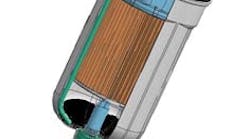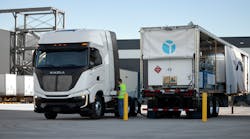Water in fuel can cause serious maintenance issues, such as enhancing corrosion of fuel system components and accelerating wear on fuel components by reducing lubrication. Additionally, water in fuel promotes microbiological growth, which may plug filters prematurely and adhere to fuel system components.
Water can be found in fuel in three different forms: dissolved, free or course and emulsified, says Robert Braswell, technical director of Technology & Maintenance Council (TMC). A technical council of American Trucking Associations (ATA), TMC is North America’s premier technical society for truck equipment technology and maintenance professionals. ATA is the largest national trade association for the trucking industry.
Dissolved water - The presence of dissolved water in petroleum-based fuels usually has an upper limit of 100 to 200 part per million (ppm), Braswell says, but biodiesel can contain up to 1,500 to 3,000 ppm of dissolved water. Dissolved water is not known to have any damaging effect on fuel system components.
Free or coarse water - Free or coarse water does not have a universal definition, he observes. However, these terms are typically used to describe water that is not fully dispersed throughout the fuel.
SAE (Society of Automotive Engineers) J1839 test standard, “Coarse Droplet Water/Fuel Separation Test Procedure,” defines coarse water as having a mean droplet size of 180 to 260 microns. J1839 calls for a test apparatus that generates this range of water droplets to approximate field conditions, which is then used to determine the undissolved water removal performance of a fuel/water separator.
Emulsified water - Emulsified water does not have a universally accepted definition either. Nevertheless, says Braswell, this term is typically used to describe when water and fuel form an emulsion in which the water droplets are so tiny that they remain in suspension for a very long time. In high enough concentrations, it can make the fuel appear milky.
Test standards SAE J1488, “Emulsified Water/Fuel Separation Test Procedure,” and ISO (International Organization for Standardization) 4020, “Road Vehicles - Fuel Filters for Diesel Engines - Test Methods,” are used for quantifying filtration performance with emulsified water.
“Fuel/water separators are designed to remove free/coarse and emulsified water,” says Braswell. “They typically employ one or more methods to remove these types of water. Gravity is commonly used to aid water separation and precipitate water removed by the filter into a settling chamber where it can be drained during maintenance intervals.”
Water removal methods
The various methods of water removal are briefly described below:
Coalescer - A device or medium which unites relatively small water droplets to form larger droplets which are more easily removed from fuel.
Stripper - A device with a filter medium that allows fuel to pass through, but traps water on its surface. As more droplets are removed they coalesce to form larger droplets until they are large enough for gravity to transport them to a settling chamber.
Water stripping can be accomplished by using filter media containing certain fiber material or by applying a chemical treatment to the filter media.
Change in flow direction - A method in which a sharp change in fuel flow direction causes the water to separate due to inertia. This is commonly combined with gravity to aid in water separation.
This method is not effective for very small droplets. Heavier droplets respond better to inertia and gravity effects.
Centrifuge - A device that separates water from fuel due to the fact that water has a higher density than fuel.
Decrease in velocity - A method in which decreasing the velocity of the fuel flow allows the water to more readily separate from the fuel.
Settling tank - That portion of the water separator device where there is no or very little fuel velocity; usually at the bottom of the device. This “quiet” area allows water droplets to settle out and remain at the bottom and not be re-entrained in the fuel.
RECOMMENDED MEASURES
Among TMC’s many Recommended Practices (RP) is one that offers guidelines and advice on how to best specify fuel/water separating devices used on heavy duty, diesel-powered commercial vehicles. Newly revised, it is TMC RP 317A, “Fuel/Water Separation Devices.”
To combat water in fuel, TMC offers the following recommendations:
1. Select a micron rating and water separation performance level that meets the engine manufacturer’s recommendation. “Choosing filters with unacceptably low particle efficiency may result in fuel system damage,” points out Braswell. “Conversely, filters that are too efficient may result in unacceptable short service intervals.”
Short filter life may be caused by factors that cannot be controlled by equipment owners/users, such as dirty fuel and/or unstable fuel that breaks down and plugs filters, he says. However, there are some measures that can be taken to minimize other causes of short filter life. For example:
If filters plug prematurely due to dirty fuel, specify that filters be used on dispensing pumps to pre-filter the fuel.
Contact your fuel supplier for information on how to test fuel tanks for microbiological growth and remedies to eliminate it.
In cold weather wax can build up on the filter from the fuel. Fuel/water separator heaters and/or fuel additives are available to minimize waxing problems.
Do not use a filter with a micron rating higher than that recommended by the engine manufacturer in an effort to solve short filter life unless there is another filter downstream to perform the final filtration.
2. Pay close attention to location and mounting considerations, counsels Braswell. Fuel/water separators are designed to allow a high level of mounting flexibility. Therefore, keep the following in mind when spec’ing location and mounting:
Fuel/water separators should be located at or below the level of the fuel pump to avoid air problems.
The inlet of the fuel/water separator should not be mounted below the top of the fuel tank to prevent fuel from siphoning from the tank when the unit is serviced.
If the fuel/water separator inlet cannot be installed above the tank, a shut-off valve must be installed close to the fuel/water separator.
The most desirable location for a fuel/water separator is inside the engine compartment, where maximum protection from wind and weather is realized.
If a fuel heater is used, the fuel heater should be located before and near the fuel/water separator. Many devices have built in options for co-location.
In areas of extreme low temperature, fuel lines and fuel/water separator insulation may be necessary.
When a fuel/water separator is directly mounted to the engine or other high vibration area, consideration should be given to bracket design and stress on fittings and lines, as well as to filter performance.
The mounting location should be accessible for service and draining. Most separators are mounted on the frame rail, which makes servicing easier and less time consuming.
Avoid positioning in an area of extreme heat.
3. “Location can impact performance when air or fuel leaks arise,” Braswell says. “Fuel/water separators are predominately located on the suction side of the lift pump, so any leaks will result in air being sucked into the fuel while the engine is running. These same types of leaks can cause fuel leakage when the engine is shut down.”
To minimize these types of problems, TMC says consider the following:
When changing filters, replace all seals included with replacement kits and tighten spin-on filters or cartridge covers to the recommended torque value specified by the manufacturer.
Check the connection fittings and ensure that thread sealant is used on pipe thread fittings. If straight SAE fittings are used, ensure that seals are in good condition. Some fuel lines are fabricated from plastic hose with push locks or compressions. “Don’t overlook the hose-to-fitting connection as a possible leak point when diagnosing air leaks,” says Braswell.
4. Select a device with a large enough water sump capacity to coincide with expected water drain intervals for a given operating environment.
5. Pay attention to the installation and routing of fuel fittings and fuel lines. When installing fittings, paste type thread sealant should be used on clean threads. Proper torque is to be used, particularly with plastic housings.
Ninety-degree fittings should be avoided when ever possible, says Braswell, so as not to add any unnecessary restriction. If use of 90-degree fittings is unavoidable, use the next larger size.
For example, a fuel system that flows 120 gallons per hour using two 90-degree fittings with a 1/2-inch diameter will add 0.5 inches of mercury restriction. If the diameter of the two fittings was increased to 0.625 inch, the restriction will be reduced to 0.2 inches of mercury.
“Fuel flow rates of given engines vary substantially from manufacturer to manufacturer,” Braswell says. “It is of prime importance that the flow rate be known in every instance and a fuel/water separator of corresponding capacity be used.
“The engine manufacturer will be able to provide information to specific flow rates and, allowable pressure drop - resistance in fuel flow. When mounting of the fuel/water separator necessitates a substantially longer fuel line, consideration should be given to using the next larger size line.
Additional information and spec’ing tips can be found in TMC RP 317A, “Fuel/Water Separation Devices.” It is published in TMC’s 2010-2011 Recommended Practices Manual. TMC RP 317A is also available separately from TMC. For more information, call TMC at (703) 838-1763 or visit TMC’s website at tmc.truckline.com.



